The model I use is an effective tool to help you record data about how your organization performs today. It enables viewing the organization as a whole entity, rather than just a collection of pieces. It illustrates the interdependent relationship between key organizational elements and also the cause-effect chains that impact on results. It assists in identifying key leverage points – those few elements which could affect a positive shift in the organization’s total performance.
“All organizations are perfectly designed to get the results they get” (Arthur W. Jones, ex P&G).

Already since my early years in P&G, we looked at our organization design based on the model described by Dave P. Hanna (The Organizational Survival Code, 2013). Each time we weren’t satisfied with the results, we assessed the health of the current organization design, and adapted what was needed to ensure a High Performing culture and organization.
Also during my time at Kellogg, we successfully applied the same principles across our world wide Supply Chain organization and manufacturing plants.
No nonsense approach – no fancy or expensive terminology – but common sense and real actions
Spending sufficient time on this full diagnosis, allows the leader to get an objective and realistic view on what is really happening today in the organization, and where the pain points are. Understanding those, and where they come from (identifying the root cause) allows the leader to then make the appropriate changes.
Interested to learn how this model can support your organization?
Contact Martine Van Campenhout for an exploratory conversation.
Meeting space
Kardinaal Mercierplein 2
2800 Mechelen – Belgium